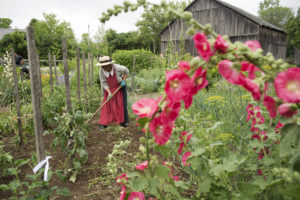Blend bounty with beauty at Doon Heritage Village
By Valerie Hill | Photography by Peter Lee
Local history grows in the gardens at Doon Heritage Village.
Take, for example, the garden behind the 1820 Peter Martin house, the original home of an Old Order Mennonite family. Here, rows of carrots and beets grow thick and healthy in the dark soil while the aptly named pole beans snake their way up cedar-rail posts. The lush display is what Bob Wildfong, the village’s horticultural specialist for the past 20 years, calls “a typical kitchen garden” for the era.
Such gardens supplied farmhouses with fresh produce, from cucumbers and beets for preserves to gooseberries and red currents for pie and jam. Everything an inventive cook could need was just outside her door.
“The idea was that it was close to the kitchen,” Wildfong says. “The larger crops – squash, potatoes – were grown in a field.”
The kitchen gardens developed by Wildfong, who is also executive director of Seeds of Diversity, a Canadian organization that promotes and conserves biodiversity, contain about 200 heritage species.
These early settlers knew how to use all the plants in their gardens. For example, an ornamental grass called Job’s Tears would be harvested for its hard, nut-like seeds, which were used as beads. Adding pinches of sorrel would give food a “lemony zing,” while lemonade was made from lavender.
“You couldn’t get lemons, so they made mock lemonade,” Wildfong says. “Lemonade was a luxury food.”
These were functional gardens, with only a few dashes of colour from hollyhocks, zinnia and pink lavatera.
“I think it was important in the period when they didn’t have much colour in their lives,” says Wildfong. “If everything was brown and grey and green, how amazing would that look to have colour?”
But there was also that tricky issue of not showing off.
“They tried not to have that kind of display of pride in things they owned, but gardens were OK, that was God’s pallet,” he says.
Unlike modern times, gardens of a century ago were not a place to hang out. However, the 24-hectare pioneer village does have one house, the 1850 Seibert House, that illustrates how wealthier families would have enjoyed a large flower garden complete with chairs. Having a garden party in such a space would have been a sign of privilege.
“It was a status symbol that you don’t have to grow your own food,” he says.
Exactly where did all these plants come from, given few were native to this part of Ontario? The kitchen garden is an example of vegetables that would have been grown in Pennsylvania, where many of the Mennonite pioneers to Waterloo Region originated. Others, particularly refugees following the First and Second World War, had few possessions but they could easily bring a few seeds, their only memory of home.
Wildfong says seeds for heritage fruit and vegetables are more readily available today through companies such as Heritage Harvest Seed in Manitoba.
Wildfong volunteered as a gardener in the heritage village in the 1990s before being hired as a horticulturist and setting off on his adventure of discovery.
He wondered what would have been growing in those early gardens and fortunately he had access to a lot of archives from the adjacent Ken Seiling Waterloo Region Museum. “I looked at copies of seed catalogues from 1910 and 1911 to see what was selling from the (Waterloo-based) Ontario Seed Company,” he says.
The catalogues became his road map. He just needed to track down the seeds – a hunt that continues. His newest project is developing a garden of plants that would have been grown by the Indigenous people, plants such as broom corn, buffalo sage and sweet grass among other species.
Everything he grows, from the newer plants to the heritage varieties, all do well. Other than the care provided by Wildfong and his 10 volunteers, he has one secret weapon.
“Thirty years of horse manure,” he concludes with a laugh.

